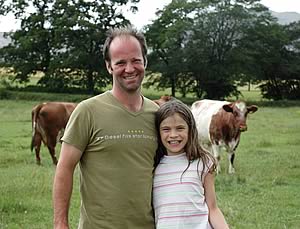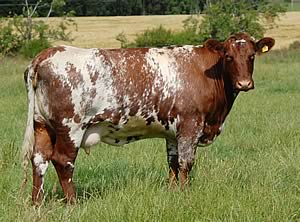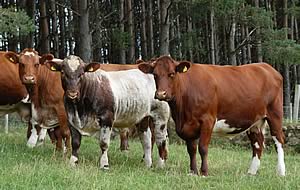 |
|||||||||
|
||||||||||||||||||||||
|
|
Beef
Shorthorn Joins Blelack Line-Up 09/10/06 The Blelack herd prefix which is synonymous with top quality pedigree cattle breeding now lends itself to a herd of Beef Shorthorns.
Blelack Farm, Dinnet near Aboyne in Aberdeenshire was put on the map 42 years ago when Neil Massie established his noted Aberdeen Angus herd. Several years later he was one of the early UK breeders of Charolais cattle and Neil’s son Graeme today runs 110 Angus and 140 pedigree Charolais cows alongside his recently founded herd of Beef Shorthorns. “I have always liked the Beef Shorthorn and probably because of disease problems, people are going to be more inclined to run closed herds of both pedigree and commercial cattle,” said Graeme Massie who with his wife Annie has nine year old twins, Jack and Hayley. “I’m not sure that some of the continental breeds used as suckler cows are as suited to Scotland’s west coast in particular. “The Shorthorn is structurally very correct and has a bit more skin to withstand the wetter coastal climate. They are also known for their longevity. “They are so docile they are ideal for today’s economic climate without subsidies where producers need to run larger herds of over 200 cows with less staff. “We also need suckler cows that can make milk cheaply – which is what the Shorthorn can do.” Blelack’s 750 acres runs from 750ft to 1,000ft above sea level and the sandy soil allows most of the cows to be outwintered on the higher ground. The two long-established beef herds are run very much on commercial lines, with half the Charolais calving in the autumn and the remainder in the spring along with the Angus herd from March to May. Graeme and Neil Massie now plan to use their expertise to slowly build up the Beef Shorthorn herd which was started three years ago, with the aim of producing top quality animals to rival their other breeds. Blelack achieved in 2004 what was the highest price for an Aberdeen Angus since the 1960s when they sold the supreme champion, the April 2002 Blelack Ellerman for the top price of 28,000 guineas. The herd has achieved seven Perth champions in nine years. The Charolais herd has had three Perth champions and a top price of 21,000gns.
Blelack’s first Beef Shorthorn was bought for 4,800gns at Perth at the autumn 2003 sale from Christopher Marler, of Olney, Buckinghamshire – Blythsome Jut with her bull calf Wavendon Empire Maker. The cow goes back to one of the breed’s top herds, Uppermill. The first cow is now 12 years old and the sale of her bull calf in Perth at 22 months old at 5,200gns more than paid for the initial investment. Since then to establish around half a dozen foundation females, other private purchases of similar bloodlines have been made from the Wavendon herd with the intention of finding two or three of the best cow families. “We intend to take the establishment of the herd quite slowly and concentrate on a few good lines and run a herd of 20 to 25 cows,” said Graeme Massie. “With the type of cattle we have bred with our Charolais and Angus herds we have always gone for power, with great locomotion and strength of character. “And just like with the other breeds, we’re also looking in the Shorthorn for an animal that has got scale, without being over the top, with power and muscle and real flesh about it. “We have always bred animals which are capable of breeding really good quality commercial cows and we’re looking for the same standards in the Shorthorn.” Numbers of Beef Shorthorns and breeders are on the increase and Graeme Massie believes that the time and money spent will be worthwhile.
Neil Massie has also been to visit Beef Shorthorn herds in Canada and embryos were brought back from two females – Myrtle and Rose. Myrtle embryos by Dust Buster have been a big success producing four heifers, and Rose was flushed to El Benito. A total of 13 bulls and six heifers have been born so far. Dust Buster, a very correct and muscular bull, was the Beef Shorthorn champion at Farmfair International in Alberta, selected by Scottish judge Donald Biggar. The Blelack herd’s eight cows and seven heifers have all been served with a 16 month old ET Dust Buster son out of Myrtle. The emphasis on breeding the Shorthorn for its female qualities. Both the established herds have been performance recorded for 30 years and it is likely that the Shorthorns will be from 2007. Shorthorn heifers are calved at two years old or over. The outwintered females are fed home-grown ammonia treated barley straw grown on 90 acres, switching to grass silage after calving. Calf creep is kept to a minimum and only during the few weeks running up to housing in the autumn. The calves are weaned in October with the bull calves being fed a diet of straw, silage, oats and dark grains for the winter. Bulls not suitable for breeding are castrated. They are turned out in the spring to grass when bulls for the Perth October and February sales as well as the home market are selected. © Copyright 2006 Jennifer MacKenzie All Rights Reserved.
|
|||||||||||||||||||||

|
|
|||||||||||||||||||||
| home | agri-services | pedigree
pen | news | dairy | beef | machinery quota | property | organisations | site map |
||||||||||||||||||||||

Article by
Jennifer MacKenzie


